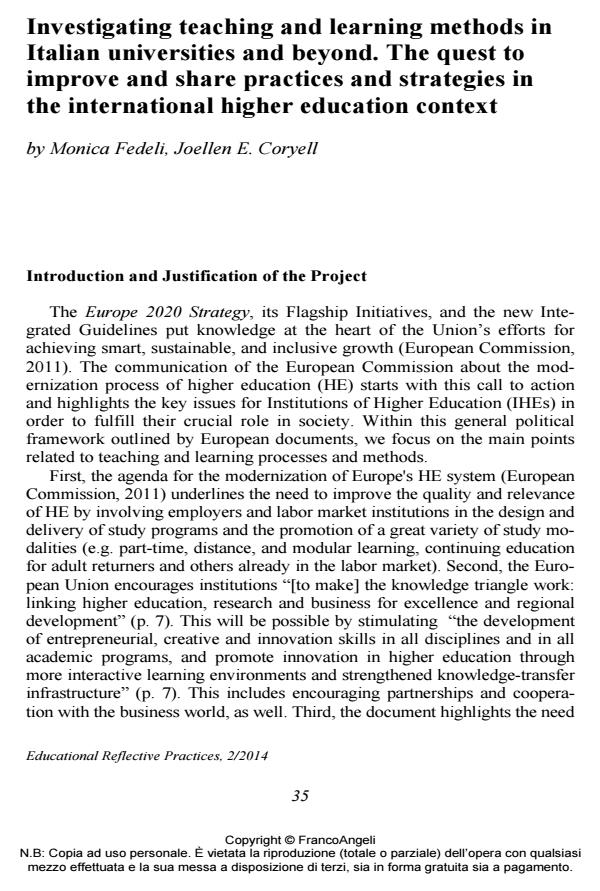Investigating teaching and learning methods in Italian universities and beyond. The quest to improve and share practices and strategies in the international higher education context
Titolo Rivista EDUCATIONAL REFLECTIVE PRACTICES
Autori/Curatori Monica Fedeli, Joellen E. Coryell
Anno di pubblicazione 2015 Fascicolo 2014/2
Lingua Inglese Numero pagine 16 P. 35-50 Dimensione file 121 KB
DOI 10.3280/ERP2014-002003
Il DOI è il codice a barre della proprietà intellettuale: per saperne di più
clicca qui
Qui sotto puoi vedere in anteprima la prima pagina di questo articolo.
Se questo articolo ti interessa, lo puoi acquistare (e scaricare in formato pdf) seguendo le facili indicazioni per acquistare il download credit. Acquista Download Credits per scaricare questo Articolo in formato PDF

FrancoAngeli è membro della Publishers International Linking Association, Inc (PILA)associazione indipendente e non profit per facilitare (attraverso i servizi tecnologici implementati da CrossRef.org) l’accesso degli studiosi ai contenuti digitali nelle pubblicazioni professionali e scientifiche
The present paper aims to describe the first phase (12 months) of an Italian research unit, which is part of a more extensive three year project that endeavored to: design innovative programs for higher education, to promote personalized learning, to build on job competencies, to value talents, to create new work opportunities, and to provide positive strategies in higher education to support young adults during their employment emergency as a response to the socio-economic crisis and as a citizenship action. In response, a consortium of universities and researchers, called Emp&Co (Employability and Competences) was created. The project involves six Italian Universities (Padova, Firenze, Siena, Napoli, Molise, Roma Sapienza), and Dr. Monica Fedeli from the University of Padova is the Principal Investigator. Dr. Fedeli’s research group is focusing on the innovation of teaching and learning methods and promotion of personalized programs in order to modernize university didactics, to encourage the university-business dialogue, and to promote employability. In the first phase of the project, a literature review was conducted and an analysis of student evaluation questionnaires on didactics, from 8 Italian, 3 American, 5 European, 1 Canadian, and 1 African University was completed to compare and learn from the different ways in which courses are evaluated by students in the different academic contexts. The goal at the end of the first year is the creation of a questionnaire template focused on teaching and learning methods, in order to gain a better understanding of student perspectives in our country. Additionally, we hope to implement strategies that will improve university didactics as requested by all European Union declarations. This paper introduces the overall study and the foregrounding work done with Dr. Joellen Coryell from Texas State University in the United States, who is a consultant to the University of Padova in the areas of adult and higher education teaching and learning.
- Theory and Practice for Understanding Process and Outcomes of Transformative Learning Claudio Melacarne, Alessandra Romano, in EDUCATIONAL REFLECTIVE PRACTICES 2/2019 pp.214
DOI: 10.3280/ERP2018-002014 - Effective Multimodal Interaction for Online and Hybrid Teaching Antonella Giacosa, pp.27 (ISBN:978-3-031-77384-6)
Monica Fedeli, Joellen E. Coryell, Investigating teaching and learning methods in Italian universities and beyond. The quest to improve and share practices and strategies in the international higher education context in "EDUCATIONAL REFLECTIVE PRACTICES" 2/2014, pp 35-50, DOI: 10.3280/ERP2014-002003